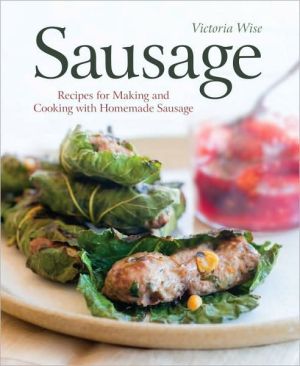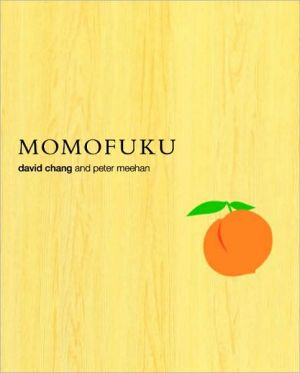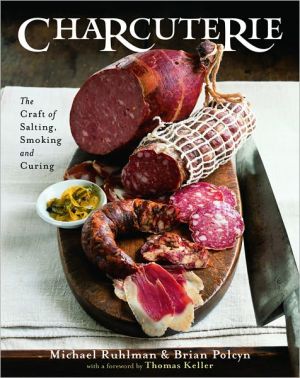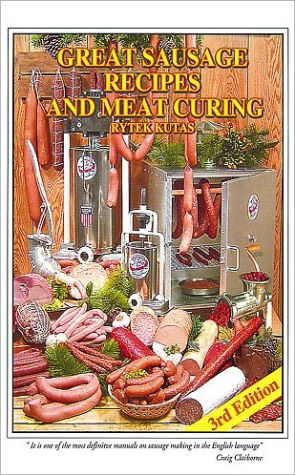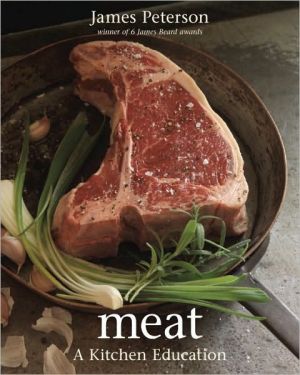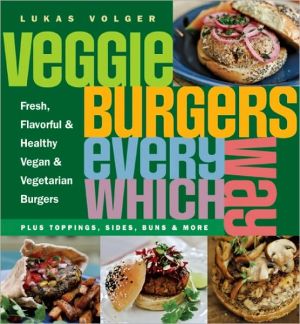Sausage: Recipes for Making and Cooking with Homemade Sausage
Think Beyond the Link \ \ You don’t have to be an expert cook or have a fancy kitchen to make sausage at home. If you simply think beyond the link, you’ll find a whole world of sausage possibilities. Patties, meatballs, fish balls, veg balls, meat loaf—these are all sausages without casings that are every bit as savory and satisfying as their linked cousins. And, since they do not require special equipment, they are a snap to make at home.\ \ In Sausage, Victoria Wise shares...
Search in google:
Think Beyond the Link You don’t have to be an expert cook or have a fancy kitchen to make sausage at home. If you simply think beyond the link, you’ll find a whole world of sausage possibilities. Patties, meatballs, fish balls, veg balls, meat loaf—these are all sausages without casings that are every bit as savory and satisfying as their linked cousins. And, since they do not require special equipment, they are a snap to make at home. In Sausage, Victoria Wise shares more than 75 recipes for easy-to-make, no-casing-required pork, beef, lamb, poultry, seafood, and even vegetarian sausages, including innovative recipes that turn them into sophisticated meals. An inviting and wonderfully diverse collection from all around the globe, this compendium features European classics, American mainstays, Asian favorites, Middle Eastern inspirations, and sausages African in origin. You will find dishes for every meal and occasion, such as Rustic Cornmeal Pancakes Dappled with American Breakfast Sausage and Slicked with Maple Syrup; Lunch Pie, aka Quiche, with Toulouse Sausage and Spinach; Vietnamese-Style Beef Sausage and Vegetable Spring Rolls with Mint Dipping Sauce; and Merguez and Apple Tagine over Couscous with Harissa. For those who like their sausage in traditional links, Wise offers expert direction for stuffing sausage into casings. Beautifully written and photographed, Sausage is the only book of its kind. Its array of inventive sausages and sausage-centric dishes are inspiration for both the new and the well-seasoned cook. Making sausage at home has never been so easy—nor the results so delicious. Publishers Weekly Clearly authored for those who prefer knowing how the sausage is made, Wise (American Charcuterie) writes with the gentility of a woman who owned and operated her own French-style charcuterie in Berkeley in the 1970s, and with the precision of an author of 12 previous books. Here she guides us through the making of a vast array of sausages that can either be shaped by hand or stuffed into casings. She also provides a variety of international recipes that incorporate the freshly made creations. Chapters are broken out by main ingredient, be it pork, beef, lamb, poultry, or seafood. There are even three vegetarian entries for the tofu, bulgur, and brown rice crowd. The classics are all accounted for, including a chorizo made with plenty of garlic for use in a black bean chili, and a basic lamb and rice sausage for stuffing grape leaves or bell peppers. Sweet Italian sausage, with fennel and thyme, is at the heart of a Pittsburgh-style sausage sandwich, while more exotic options include a Vietnamese-style beef meatball made with mint, cilantro, and Thai fish sauce. A gefilte fish recipe in a book with this title may strike some as culinarily sacrilegious, but Wise justifies the entry, simmers her ground white-fish dumplings in a broth of fish bones and heads, and explains that gefilte is actually the Yiddish word for “stuffed.” (May)
Sausage\ Recipes for Making and Cooking with Homemade Sausage \ \ By Victoria Wise \ Ten Speed Press\ Copyright © 2010 Victoria Wise\ All right reserved.\ ISBN: 9781580080125 \ \ \ Ingredients\ \ You don’t have to stock up on exotic ingredients to use the recipes in this book. On the contrary, nearly all the ingredients are familiar and readily available. Here’s what you’ll need for making the sausages and for cooking the dishes that include them. The first part covers store-bought ingredients, and the second describes homemade ones.\ \ Store-Bought Ingredients\ \ Meats \ \ Use meats, preferably organic, with a moderate amount of fat. If purchasing ground meat, it should have at least 15 percent fat and no more than 20 percent. If it has more, the texture of the sausage will be too soft. How finely or coarsely the meat is ground is also important. In general, a medium grind is what you want. Lamb routinely comes in a medium grind. Beef does, too, except for so-called chili grind, which is too large to soften into a tender sausage. Ground pork is generally more problematic. It is often excessively trimmed of fat to suit the no-fat mindset that currently prevails, and is too finely ground for making sausages with sufficient texture. Amending pork that is too finely ground with minced fat solves the problem, which is how the recipes in this book return succulence and texture to finely ground leanpork. Or, of course, you can grind your own meat. See page 153 for information on which cuts to use. \ \ Fats\ \ Pork Back Fat Pork back fat, also called fatback, barding fat, and in German speck, is the fat that runs along a pig’s back. It is the preferred fat for sausages, both for its flavor and because it sets up well after cooking, providing succulence without flabbiness. It is not readily available in markets. But, if you purchase pork loin or pork butt untrimmed, you can trim them and stockpile the fat in the freezer to use in place of back fat for making sausages. However, that is a considerable chore for slow gain. \ \ Leaf Lard Leaf lard, the delicious, hard fat from around the kidneys, is also suitable for sausages, though it, too, is hard to come by. It can sometimes be special ordered, or you might check with pork purveyors at farmers’ markets, who are typically devoted to pasture raising, humanely slaughtering, and using the whole hog. \ \ Salt Pork To substitute for back fat or leaf lard, I use salt pork, the fat from the belly with striations of meat running through it. It is not as hard as back fat, but it is almost as satisfactory for sausages. Lean pork belly is used for bacon, the meat bands being what is wanted. For sausages, it is the opposite: the fat is the prize, so choose pieces that have the most fat. There are several brands of salt pork on the market, usually sold in vacuum-wrapped blocks of about 6 ounces. Some come still crusted in salt; some come basically desalted. The former needs to be rinsed several times and then blanched in boiling water for 5 minutes to leech out the salt. The latter is ready to go, with the proviso that you must be judicious when adding salt to the recipe. That’s an easy call: cook a small sample of the sausage mixture, taste it, and continue from there. In recipes that call for salt pork, I have included a line that reminds you to test for saltiness before you add more salt.\ \ The most facile way to mince salt pork without a meat grinder is to freeze it partially, enough so that a knife blade glides through it without mashing it. Then use a chef’s knife or food processor, first cutting it into small pieces, to chop it as finely as possible. \ \ Oils I almost always use extra virgin olive oil. Some years ago, this seemed rather fancy and imprudent for everyday use. That was then. Nowadays, many, many extra virgin olive oils are available. They range from not so expensive to quite pricy. For cooking, I use a medium-priced extra virgin oil. Lesser grades are not worth the money you pay for the word olive on the label. Instead, when I want a vegetable oil other than olive oil, I use peanut oil. It has more viscosity, which means it is not as thin and watery as many other vegetable oils, such as canola or corn oil, and it has a high smoke point, making it a good choice for high-heat sautéing or frying. Many brands of peanut oil are on the market, and they vary in how much flavor they impart to a dish. I use a neutrally flavored peanut oil, rather than a more full-flavored, expeller-expressed artisanal product. A note of caution: keep in mind that peanut oil is potentially very harmful for those who are allergic to peanuts. When in doubt, use canola oil. \ \ Butter Heretical though it may sound, the difference between salted and unsalted butter is not of as much importance to me as it is to, say, a pastry chef. In general, for savory dishes, the nuance of salt in salted butter does not interfere with other tastes. I have tried many high-end, expensive domestic and imported butters and found that most are not worth the price. There is an exception. I love Parmigiano-Reggiano butter, which comes from the region where Parmigiano-Reggiano cheese is produced. It is made from cream collected from the same dairy cows that produce milk for the manufacture of the world-famous cheese. Other than butter that you might make yourself, this is the one that best retains the sweetness of truly fresh farmstead butter. Unfortunately, it is dear, maybe even a little exorbitant, so I reserve it for uses where the butter is key, as in butter sauces or for slathering on bread. For everyday cooking, I choose a good-quality domestic organic butter, either salted or unsalted. \ \ Herbs\ \ For the most part, I purchase herbs fresh. But experience has taught me that fresh herbs do not keep well. Indeed, no matter how they are refrigerated—wrapped in paper towels or stood in a glass of water—they will begin to rot after 4 or 5 days. So, as soon as a fresh herb bundle shows signs of deteriorating, I untie it, place it in a small bowl, and set it in the cupboard, uncovered, so it can slowly air dry. Then, I use it at whatever stage it is at the moment I need a teaspoon or so for the dish I am cooking. I have found this to be a very satisfactory way to have fresh herbs and freshly dried herbs always on hand. Keep in mind that dried herbs are more concentrated in flavor, so if a recipe calls for 1 teaspoon of a fresh herb and what you have is dry or almost dry, use only 1/2 teaspoon.\ \ Spices \ \ Volumes have been devoted to spices and their magical, commercial, curative, and culinary powers. Here, in brief, I will say only that I keep a shelf filled with spices, arranged in alphabetical order so they’re easy to pull out for a recipe without fumbling through the whole cupboard. I buy them in small amounts and keep them in tightly capped jars so they stay fresh for several months.\ \ Salt and Pepper \ \ For cooking, I use kosher salt because it is inexpensive and flows freely without the use of additives. Fine sea salt is also a good choice, but if you opt for it, pull back on the measurement a bit: 1 teaspoon kosher salt is equal to 3/4 teaspoon fine sea salt. For condiment salt, I enjoy the sizes, shapes, and colors of salt crystals, which can be found in gourmet markets. They are expensive, however, and other than the fun you can have discerning minimal taste differences, I don’t find one type is a better choice than another. So, I have settled on sel gris from the Brittany coast of France, where the salt beds have been tended as lovingly as a garden for centuries. Its gray (gris) color comes from the clay in the shallow marshes where it is harvested. It is moist and has medium-size soft crystals, so that it melts in the mouth and then disappears before intruding its presence on the dish it is garnishing. Unlike other condiment salts, sel gris is also a fine cooking salt because it readily and smoothly blends into its surround, leaving no trace of its crystalline origin. Also, it is not expensive so you can use it expansively.\ \ I employ mostly black peppercorns but use white peppercorns when I don’t want black specks to be visible in the mix. There is not a huge taste difference between black and white pepper, except that white is a little more nutty and softer on the tongue than black pepper. I also sometimes use green peppercorns, which are elusively herby and at the same time peppery. I always grind peppercorns to order.\ \ \ \ American Breakfast Sausage\ \ Breakfast sausage, in patties or links, is a staple of the great American breakfast plate. It’s an important player in the hearty, stoke-up-for-the-day meal that includes eggs, cooked anyway you’d like; toast or pancakes; and mugs of hot java. It is served on the road as early as 4 a.m. to truckers and workers off to the fields or factories. A bit later, it feeds tourists fueling up for a day’s adventure of skiing, mountain climbing, and other energetic activities. And on Sunday mornings, home-style cafes are filled with customers looking to splurge calories on a big breakfast out. But you don’t need to stop at breakfast when using this sausage. It also makes a delicious taco filling or pizza topping. As often as not, breakfast sausage is served in patties, but if you prefer links, you can stuff it into sheep casing. Makes 1 pound\ \ 14 ounces ground pork\ 2 ounces salt pork, fat only, minced\ 3/4 teaspoon rubbed sage (not ground sage)\ 1/2 teaspoon dried thyme\ 1/2 teaspoon dried marjoram \ Scant 1/4 teaspoon powdered ginger\ 1/4 teaspoon freshly ground black pepper\ 1/8 teaspoon cayenne pepper\ 1 teaspoon kosher salt, or to taste, if needed \ \ Place all the ingredients except the salt in a medium bowl, and knead with your hands until thoroughly blended. Cook and taste a small sample, then add the salt if needed. Leave in bulk and shape as directed in individual recipes or stuff into sheep casing. The sausage can be used right away. (The uncooked sausage will keep in the refrigerator for up to 3 days or in the freezer for up to 1 week.) \ \ Sauté or grill, or cook as directed in individual recipes.\ \ \ Rustic Cornmeal Pancakes Dappled with American Breakfast Sausage and Slicked with Maple Syrup\ \ The advantage of including the sausage in the pancake batter is that you don’t have to use a second pan to cook the sausage for a side. It saves thermal unit energy, making it eco-friendly, and it saves the energy of the cook because there are fewer dishes to wash. The addition of polenta, which is more coarsely ground than cornmeal, makes for a slightly nubby texture and pleasing “bite.” For an everyday breakfast, I usually make the pancakes plate size, but they make a fine stack of dollar-size pancakes, too, if you’d like to go for “more” rather than “bigger.” Use about 2 tablespoons for each dollar-size cake; you should end up with about 18 pancakes. The batter, without the added sausage, can be stored in the refrigerator for up to 4 days; just before cooking, stir in the crumbled sausage. Using grade B maple syrup accents the rustic theme. It is also the grade recommended by savvy Vermonters, who prefer its deeper, browner lushness over grade A. Makes 6 plate-size pancakes \ \ 1 1/2 cups yellow cornmeal\ 1/2 cup polenta\ 1 1/2 cups boiling water\ 3/4 cup all-purpose flour\ 2 teaspoons baking powder\ 1 tablespoon sugar\ 3/4 teaspoon kosher salt\ 1 cup milk\ 1 large egg\ 3 tablespoons butter, melted \ 6 ounces American Breakfast Sausage (page 10)\ Butter or ghee (see page 71), for cooking the pancakes \ Maple syrup, preferably grade B, for serving\ \ To make the pancake batter, place the cornmeal and polenta in a large bowl and slowly pour in the boiling water, whisking to mix it in as you go. Set aside to soften the grains while preparing the remaining ingredients.\ \ In a small bowl, combine the flour, baking powder, sugar, and salt and stir together with a fork. Combine the milk and egg in another small bowl and whisk to mix. \ \ Add the milk mixture and melted butter to the cornmeal mixture and whisk to mix. Whisk in the flour mixture to make a thick, coarse batter. Crumble the sausage and stir it into the batter.\ \ Preheat the oven to 250ºF. Generously grease a heavy, 8- to 9-inch skillet with the butter and warm it over medium-high heat. Ladle about 1/2 cup of the batter into the skillet and cook until golden on the bottom, about 5 minutes. Flip the cake with a spatula and continue cooking until golden on the second side, 2 to 3 minutes more. Transfer to a baking sheet and place in the oven to keep warm. Continue until all the batter is used.\ \ Place a pancake or two on individual plates and drizzle maple syrup across the top. Serve. \ \ Continues... \ \ \ \ Excerpted from Sausage by Victoria Wise Copyright © 2010 by Victoria Wise. Excerpted by permission.\ All rights reserved. No part of this excerpt may be reproduced or reprinted without permission in writing from the publisher.\ Excerpts are provided by Dial-A-Book Inc. solely for the personal use of visitors to this web site. \ \
ix - Acknowledgments x - Introduction1 - Ingredients1 - Store-Bought 4 - Homemade 8 - Pork Sausages 62 - Beef Sausages 88 - Lamb Sausages110 - Poultry Sausages126 - Seafood Sausages 144 - A Trio of Vegetarian “Sausages”153 - Appendix: Grinding Meats and Stuffing Sausage at Home157 - Index
\ Library JournalWise (The Pressure Cooker Gourmet; American Charcuterie), who owned and operated Pig-by-the-Tail Charcuterie in California for 12 years, begins with an introductory discussion of store-bought sausage ingredients (meats, fats, herbs, spices, and salt and pepper) and homemade ingredients (fresh bread crumbs and broths) and presents recipes for pork, beef, lamb, poultry, and seafood sausages. Three vegetarian sausages are also included. The appendix features guidelines for grinding and stuffing sausage at home. Libraries should also consider Susan Mahnke Peery and Charles G. Reavis's Home Sausage Making, which includes information on equipment that is absent from Wise's book.\ \ \ \ \ Publishers WeeklyClearly authored for those who prefer knowing how the sausage is made, Wise (American Charcuterie) writes with the gentility of a woman who owned and operated her own French-style charcuterie in Berkeley in the 1970s, and with the precision of an author of 12 previous books. Here she guides us through the making of a vast array of sausages that can either be shaped by hand or stuffed into casings. She also provides a variety of international recipes that incorporate the freshly made creations. Chapters are broken out by main ingredient, be it pork, beef, lamb, poultry, or seafood. There are even three vegetarian entries for the tofu, bulgur, and brown rice crowd. The classics are all accounted for, including a chorizo made with plenty of garlic for use in a black bean chili, and a basic lamb and rice sausage for stuffing grape leaves or bell peppers. Sweet Italian sausage, with fennel and thyme, is at the heart of a Pittsburgh-style sausage sandwich, while more exotic options include a Vietnamese-style beef meatball made with mint, cilantro, and Thai fish sauce. A gefilte fish recipe in a book with this title may strike some as culinarily sacrilegious, but Wise justifies the entry, simmers her ground white-fish dumplings in a broth of fish bones and heads, and explains that gefilte is actually the Yiddish word for “stuffed.” (May)\ \
